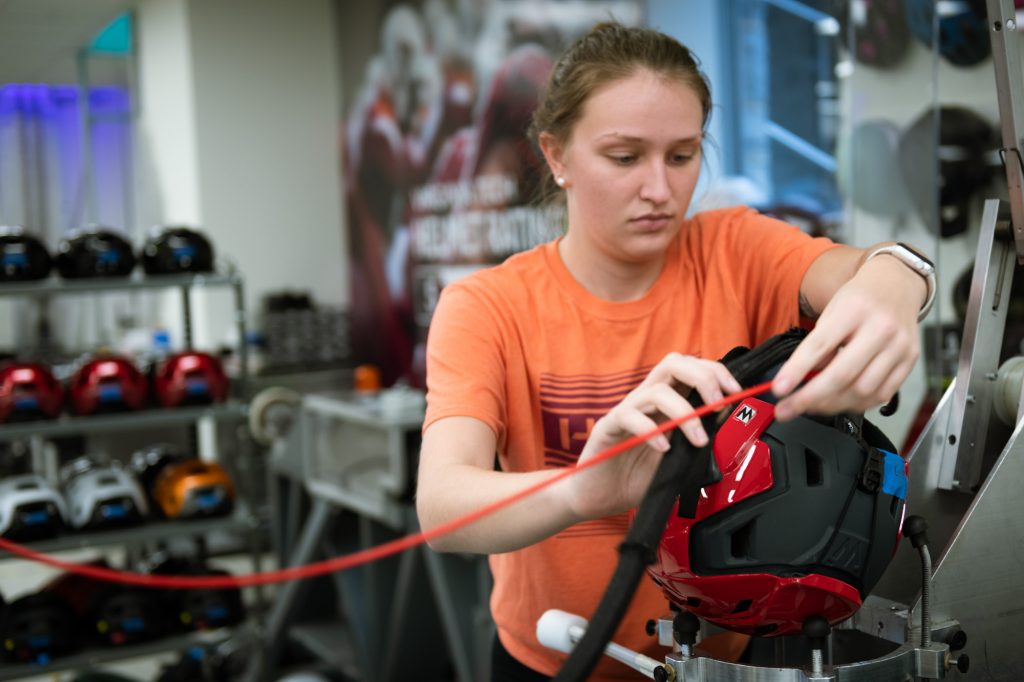
Moguls. Aerials. Half-pipe. Big air. Skiing and snowboarding events send athletes soaring through the air and racing downhill at speeds creeping over 80 miles per hour.
These high-energy sports attract a rapt audience at the Winter Olympics every four years, but they’re also wildly popular among recreational athletes. The National Ski Areas Association reported 59 million visits to skiing or snowboarding areas in the U.S. during the 2020-21 season.
But like any activity that combines high speeds and hard surfaces, snow sports come with a risk of getting hurt, and hundreds of thousands of skiing and snowboarding injuries occur annually. Head injuries account for 28 percent of those and are the No.-1 cause of fatality in these sports.
That makes it critical to know which helmet provides the most effective buffer between the head and the ground for skiers who lose their balance or a snowboarder who doesn’t stick a landing. In time for peak ski season, the Virginia Tech Helmet Lab has added snow sports to the list covered by its nationally regarded five-star helmet rating system.
Out of 35 helmets the lab tested, two helmets merited all five stars and eight earned four. The remainder earned three or fewer.
The ratings, which are built on years of Virginia Tech’s research and expertise in injury biomechanics, provide a unique, evidence-based way for consumers to know which helmets offer the best protection. They’re made possible by the lab’s rigorous analysis of what happens during a head impact in a particular sport, and which impacts are most likely to turn into injuries. The research is a collaboration with the Edward Via College of Osteopathic Medicine.
“The circumstances that lead to head injuries are unique for every sport,” said Steve Rowson, an associate professor of biomedical engineering and mechanics and the Helmet Lab’s director. “What part of the head usually gets hit? At what angle? How fast? Understanding those conditions thoroughly enough to recreate them in the lab is the key to assessing how effective helmets will be in a way that’s relevant to what athletes experience in the real world.”
The lab’s rankings are the first to evaluate how effectively snow sports helmets protect athletes from brain injuries like concussion and how they perform relative to each other.
As with most sports, the existing safety regulations for this gear are based on a standard associated with lethal injuries like skull fractures. The pass-fail metric doesn’t capture differences between helmets or assess their performance against injuries like concussion, which occur at lower levels of force but are still potentially devastating.
More granular data on helmet efficacy could help address a puzzling mismatch between trends in helmet use and injury rates. Helmet use in skiing and snowboarding has been climbing steadily. Today, more than 80 percent of skiers and snowboarders wear helmets on the slopes, up from just 25 percent two decades ago. But while rates of catastrophic injuries have dropped, rates of other injuries, like concussion, haven’t. A rating system that judges helmet performance at a border range of forces could begin to move the needle on some of those other injuries.
Snow sports are the lab’s seventh major ratings release. Rowson, along with Harry Wyatt Professor of Engineering Stefan Duma, published the first ratings for varsity football helmets in 2011. In the decade since, hockey, soccer, cycling, and youth football helmets have all been added to the portfolio.
The lab’s research has also been instrumental in understanding the risks of drone flights over people. They’re currently working on developing ratings for equestrian helmets, baseball, softball, sensors, and other sports.


